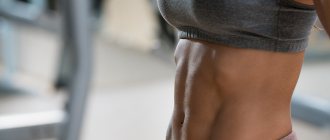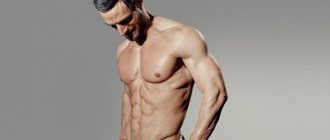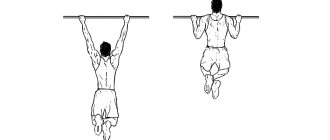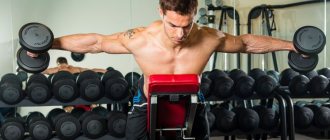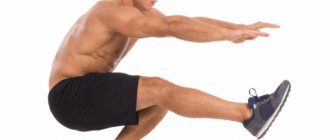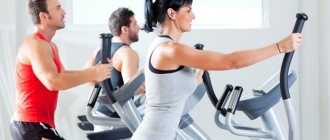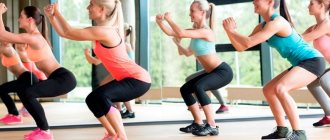Girls want to be slim, guys want to be big and strong. Regardless of your goal, you probably want to get toned abs. And this is a great desire. However, there is a problem. You've probably noticed that there are a lot of thin people, but without abs.
And here experienced marketers come to the rescue, hiding in the shadows or hovering overhead, looking for confused prey. Okay, this all sounds a little dramatic, but look at the situation.
The problem is that there is a lot of false advice on how to get six-pack abs in 30, 15 or even 10 days.
- Some people say you just need to do special abdominal exercises every day... and they are wrong.
- Others say you just need to do squats and deadlifts to get great abs... and they're wrong.
- Still others argue that you need to give up certain foods... and again they are wrong.
- The fourth seems to be closer to the truth: you just need to have a low percentage of body fat... but this is not true either.
- Still others insist that you need to take the right sports nutrition... but they are simply lying.
In fact, to lose belly fat and pump up your abs, you need to adhere to two rules, which I will discuss below. Go!
How to pump up your abs - 2 simple rules
It's not difficult to pump up your abdominal muscles. But any abdominal training program will be ineffective if you do not adhere to the following principles.
Burn belly fat
I figured I'd start with the obvious. The main reason you don't have visible abs is because you have too much fat in your abdominal area ( belly ). Get rid of excess fat deposits - and you will become closer to your goal or even achieve it altogether. The question arises: how to burn fat correctly?
Firstly, local fat burning is impossible. The myth about targeted fat burning is actively used by manufacturers of various exercise equipment (abdominal belts), magazine publishers and authors of pseudoscientific websites. Allegedly, there are special exercises for the legs, for example, and the same exercises for the abs that will help you quickly achieve your goal.
I wish it were that simple. However, science says otherwise. Research [1] has shown that training a specific muscle group results in increased levels of blood flow and lipolysis (the conversion of fat cells into fuel for the body) in that area, but these effects are miniscule.
Exercising muscles burns calories and can lead to muscle growth, which helps in fat loss. However, it does not directly reduce the fat layer covering them [2].
You see, fat burning is a process that takes place in the body as a whole.
If you maintain a calorie deficit (read here how to do it correctly), your body reduces fat reserves. Fat burning occurs everywhere, but in some areas it is faster (more on this below).
The point is, you can do hundreds of crunches every day, but you won't see a six-pack [3] until you have a certain percentage of body fat - 15% or lower for men, 25% or lower for women . The images below show everything clearly.
As you can see, the cubes begin to show through around 15% and 25% in men and women, respectively. They are really clearly visible when the fat percentage is less than 10 in men and below 20 in the fair sex.
I mentioned above that some areas of the body lose fat faster than others . Unfortunately, belly deposits are incredibly stubborn. And I'm not talking about a person, but about physiology.
There is a scientifically proven reason why fat cells in certain areas of the body are much more difficult to burn than others. Such areas, including the abdomen, contain many more alpha receptors than beta, which slows down the mobilization of fat deposits [4]. But there are also specific methods to combat this. You will learn about them in the following articles on Zozno.
Pump up your abdominal muscles
It is generally believed that people who do a lot of heavy compound exercises (squats, deadlifts, military presses, etc.) do not need abdominal training. I don't agree with this. To understand why, let's take a quick look at the structure of the abdominal muscles.
The main muscle that is associated with six-packs is the rectus abdominis.
There are also several other core muscles that complete the look, including the obliques, transversus abdominis, and serratus anterior:
The importance of developing these muscles in addition to a beautiful rectus abdominis should not be underestimated. Look at this photo - like “pumped up” abs and clearly lagging core muscles (torso muscles).
This is not a bad physical condition, but there is no visible waist taper, serratus anterior, or transverse muscles.
Some people have the opposite problem: their rectus abdominis is underdeveloped, but the rest of the abdominal area is overinflated. Here's an example:
This can happen if the obliques are overdeveloped, the rectus abdominis is lagging behind, and there are no transverse muscles and/or serratus anterior at all.
Now let's see what a well-rounded core looks like.
Sure, the model (Greg Plitt) has much better genetics than the two guys above, but he's not much drier than the second one here. He just has the perfect ratio of the rectus abdominis and other core muscles.
Any other tips on how to get toned abs?
Actually, there are no more tips for pumping up your abs. Whether you're a guy or a girl, you need to have a low body fat percentage and strong core muscles. The first goal is achieved through proper nutrition with a calorie deficit, and the second through basic and isolation exercises.
The best exercises to pump up your abs
I've seen many people with poorly developed abs who can do hundreds of crunches and plank for an impressive amount of time.
The problem here is that the core muscles are like any other muscle. They need progressive overload to grow. This requires an emphasis on weight training and increasing athletic performance over time.
One of the biggest mistakes when training your abs is not doing exercises with additional weight. As you'll see below, I recommend doing at least a few sets of these exercises during your training. However, before we model the workouts, let's talk about the individual exercises.
There are an incredible variety of abdominal exercises and a lot of opinions about what is best and what is not. Luckily, you only need to pick a few to develop your core muscles.
The exercises below are based on scientific research [5] and my personal experience. There are many more options you can make, but you're unlikely to need them.
Multi-joint exercises
The squat, deadlift, bench press and military press are not abdominal exercises per se, but they do strengthen your core. They are also extremely important for the growth of muscle mass and strength throughout the body. If you don't do them every week (or don't pay enough attention), you won't see good progress.
Crossover crunches
Crossover crunches are one of my favorite exercises because they involve weights and work the entire rectus abdominis muscle.
You can also use crunches to work your obliques by doing a side rep after your regular rep. By lateral repetition I mean touching your right elbow to your left knee and vice versa.
It turns out: regular repetition, right elbow to left knee, regular repetition, left elbow to right knee.
Leg raises
Leg raises are one of the best exercises for developing the rectus abdominis muscles, including the “lower abs,” as well as the oblique muscles. In the beginning, you can perform the exercise with your knees bent, but your goal is to work with your legs straight. After a while, you can add weight by placing a dumbbell between your legs.
Hanging Leg Raise
The hanging leg raise is similar to the previous exercise, but it requires more effort on your part to stabilize your body. Again, you can work with your knees bent at first, but you should aim for straight legs. And hanging leg raises with dumbbells will make you really sweat.
"Bike"
The bicycle exercise is a great addition to your abdominal workouts and works especially well on the obliques and transverse muscles.
Ab roller
I'm not a fan of various training devices, but the gymnastic roller is a good thing for pumping up the abs.
What is a press?
Let's first look at what abs are. That's more than the 8 pack you see in the mirror. The abdominal muscles consist of an outer layer:
- rectus abdominis muscle,
- oblique muscles;
and inner layer:
- transverse muscle,
- internal oblique.
But that's not all. The above muscles rarely work in isolation. In almost any exercise, other muscle groups are connected to them:
- adductor muscles of the thigh,
- sartorius muscle of the thigh,
- rectus femoris muscle,
- gluteal,
- back extensors.
This muscle group is called the core or midline of the body. So if you want to pump up your abs, you need to train your core.
Rules for training the press
The rules for abdominal training are very simple.
Combine exercises with and without weights
Well-rounded abs require a lot more muscle development than most people realize. Alternating exercises with and without additional weight is the most effective way to do this.
Train your abs often
How often can you pump up your abs? The optimal frequency of training is the subject of endless debate, but in general, small muscle groups recover faster than larger muscle groups [6]. Heavy exercises like squats and deadlifts take longer to recover than isolation exercises like dumbbell curls or dumbbell lateral raises. I've found that abs (as well as calves, by the way) can be easily trained 2-3 times a week in addition to basic training. This is the optimal frequency that will not lead to overtraining. Of course, you shouldn't train your abs for three days in a row. There should be 1-2 days of rest between classes. Personally, my schedule is Monday, Wednesday and Friday with three basic workouts per week and Tuesday and Thursday if I train twice.
Progress in exercises
As in training any other muscle groups, your goal in training “cubes” is to gradually progress and improve. Add pounds when doing exercises with dumbbells (extra weight) and increase the number of repetitions when doing bodyweight workouts.
Effective abdominal exercises
Popular abdominal exercises are:
- Crunches
- Leg raises
- Plank
There are many different variations of them. In fact, there are even more of them. But at the very beginning of training, you should not use all the exercises in a row. Choose a set of 2-3 movements and work on them for 8-12 weeks to get results
. Gradually increase the complexity of your workouts to create a progression of loads. Abs of steel are the result of many years of training, but the first results can be obtained in just a month of training.
I talked in detail about how to perform these exercises correctly in the video. At the end, you will find a program of abdominal exercises at home, with which you can begin your training.
How to build an ab workout
So, you know the basic rules, now let's see how best to build abs training. It's simple - you need to do circuit training, which consists of three exercises performed one after another. You will rest between circles and then repeat them.
Here's how circuit training should go:
- Do 1 set of weight-bearing exercises, such as crossover crunches, push-up leg raises, or hanging leg raises, for 10 to 15 reps. This means that if you can't do more than 10 reps, the weight is too heavy. But if you can do more than 15, it's time to add another 2 kg.
- Immediately perform any bodyweight exercise to failure.
- Without rest, do another bodyweight exercise to failure.
- Rest between circles – 2-3 minutes.
For example, here is my abdominal training program:
- 1 set of crossover crunches, 10-12 reps;
- 1 set of leg raises, to failure;
- 1 set of bicycle exercise, until failure.
- rest 2-3 min.
I usually do these circuits between sets of large muscle group exercises to save time. Eg:
- 1 deadlift approach;
- 1 circle for the press;
- rest 60-90 seconds;
- 1 deadlift approach;
- 1 circle for the press;
- rest 60-90 seconds.
And so on. I recommend doing 3 laps per workout (2-3 times a week) . As you'll see, it's harder than it looks!
// Press - home program
A home abdominal program requires 30-40 minutes per workout. Try to perform the exercises slowly and with a feeling of involving the abdominal muscles in the work. The indicated number of repetitions is approximate - beginners and girls can reduce the number, sports guys can increase it.
Lateral pelvic lifts
The first warm-up exercise in the program. Get into a side plank position on your elbow. Slowly lower your pelvis and hips down, then return to the starting position. Place your hand on your belt to better feel the work of the side press. 2-3 sets of 10 reps on each side
Side plank
Take a side plank position, one hand serves as a support, the other is raised up. Make sure that your body maintains a straight line and that your pelvis does not fall back or forward. Also make sure that your neck is not tense (look ahead or up). 2 sets of 30-50 seconds on each side
Side plank crunches
The starting position is similar to the previous exercise. As you exhale, begin to twist, moving your upper arm toward your elbow fixed on the floor. As you inhale, raise your arm up. Make sure that your pelvis is in the same position during the movement. 2-3 sets of 10-12 reps on each side
Plank on extended arms
The arms are extended, the abdominal muscles are tense and support the body weight. Stay still. To complicate the exercise, you can alternately raise your legs up. 3-4 sets of 60-80 seconds
Leg rotations in plank
Starting position - similar to the previous exercise. Keeping your abs tense, as you exhale, pull your leg bent at the knee towards your chest, then rotate it inward about 30 degrees. Make sure you feel the side press working. Switch legs. 2-3 sets of 10-12 reps on each side
Exercise Bicycle
Lying on the floor, hands clasped behind your head. One leg is extended forward, the other is bent at the knee. As you exhale, slowly stretch your elbow towards the opposite knee, tighten your abs at the top point (without lifting your lower back from the floor), then return to the starting position. Switch sides. 3-4 sets of 15-20 repetitions
Turns with the ball
Sitting on the floor, raise your knees bent to parallel. Take the ball in your hands and begin to make alternating turns to the sides, touching the floor with the ball at the final point. While moving, try to tighten your abdominal muscles as much as possible. 3-4 sets of 15-20 repetitions
Side bends lying down
Lying on your back, by engaging the abdominal muscles, lift your upper torso, then alternately “bend”, reaching your hand toward your shin. Make sure that your neck is not under excessive tension and do not lift your lower back off the floor. 2-3 sets of 10-12 reps on each side
Will sports nutrition help?
No natural substance can melt fat on its own, although you can see a lot of pseudoscientific theories about this on the Internet.
Sports nutrition manufacturers often talk about increasing fat oxidation, preserving lean muscle mass, supporting thyroid function, triggering thermogenesis, altering hormone and neurotransmitter levels, reducing water retention, improving nutrient partitioning, inhibiting fat storage enzymes, and increasing enzyme levels. causing fat burning.
In reality, these are all aspects of fat loss. But this type of marketing is nothing more than an attempt to blind you with terminology and scientific half-truths in the hope that you will simply buy into the benefits of the product.
If you take a clear-eyed look at what the science says on this subject, you'll see that proper sports nutrition can really help you. But it will never compensate for poor eating habits and irregular workout routines.
